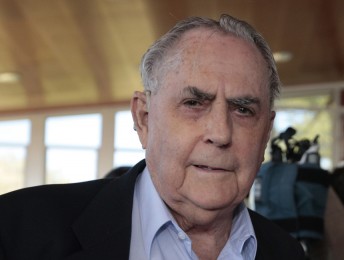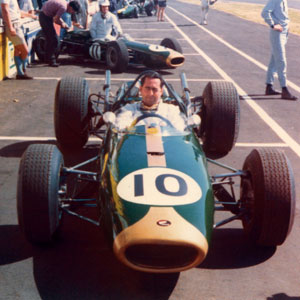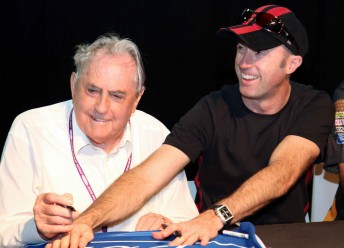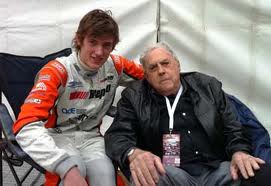

Australia’s first grand prix driver Tony Gaze once observed the rather sad fact that Alberto Ascari had died with little to show as reward for his sublime racing ability.
Ascari had successfully defended his F1 world crown in 1953 but two years later he tragically lost his life while testing a Ferrari 750 sports car at Monza.
At 36 Ascari had managed 13 wins and 17 podiums from 32 starts yet he didn’t take wealth to his grave.
Ironically the year Ascari died in an otherwise meaningless testing session, Sir Jack Brabham stepped onto the grand prix stage for the first time and would become one of the sport’s most revered figures.
Sir Jack says that along with car and track safety, the amount of money which the sport of grand prix racing now generates is the single biggest difference to his era.
“It is a big difference to what it was and unfortunately I missed it in my era,” Jack Brabham says of the tens of millions many F1 drivers earn these days.
Brabham managed to compete and survive through one of the darkest eras of the sport when competitors perished at an alarming rate.

The legendary triple world champion who continues to live in retirement on the Gold Coast said it was incredibly hard losing friends but he had been forced to live with it.
When starting to recount one of his luckiest escapes, Sir Jack offered an apprehensive chuckle when he admitted to having several near misses during his grand prix career which spanned from 1955 to 1970.
“I suppose the one that sticks in my mind more than anything is the big crash that happened at the Indy 500 in 1964 when Eddie Sachs and Dave McDonald were killed,” Brabham begins.
“I missed it by that (measuring with his thumb and forefinger barely a millimetre apart) much. It was only luck.
“I had a conversation with Masten Gregory before the race and he told me that Dave McDonald’s car was absolutely a lethal car and there was going to be an accident.
“So when the race started I was only looking at that car (McDonald’s) and I didn’t look at anything else.
“As soon as I saw him going down the straight I slowed up enough to go through the fire at right angles.

“If I hadn’t I would have been into the burning wreck with the other boys. It was just sheer luck.
“We lost Dave at Indianapolis in one of the worst cars that was ever built.
“I tried to get Dave not to drive that thing because it was a death trap.
“What Dave would have accomplished in life who knows? It was cut short so early.”
Facing up to death was more or less a regular calamity during an era when motor racing was dangerous and sex was safe.
“It was very difficult. We lost a lot of people and it was something we had to learn to live with really,” Sir Jack said.
“We just had to press on regardless of all that, hoping that it wasn’t going to happen to us.
“That was a really, really bad era and it was down to the tracks we were racing on and the cars we were driving were nothing like all the things we’ve got today. So it made it very, very dangerous.”
Perhaps the tragedy that affected Sir Jack more than any other during his career was at the Belgian Grand Prix in 1960.
“I had won the race and I was getting presented with the trophy and someone leaned over and told me that two drivers had been killed in that race and it really took the shine off it.”
The British drivers Alan Stacey (Lotus-Climax) and Chris Bristow (Cooper-Climax) had both perished in the race.
During the mid 1960’s Brabham was putting in place the engineering that would see him pull off the extraordinary feat of winning the F1 World Championship in a car bearing his own name.
“I think really that was the highlight for me winning for a third time in 1966 with an Australian engine. I don’t think that will happen again.”
Around this time Hollywood came to F1 when director John Frankenheimer started shooting the film Grand Prix which would be released in 1966.
Many of the drivers had a lot to do with the making of the film with Sir Jack one of those ‘real-life extras’ in high demand.
The problem was that Frankenheimer would often procrastinate, nonchalantly forgetting the ‘extras’ he had at his disposal had their own commitments to teams and car preparation at the height of the season. Before long a few days had passed and Frankenheimer seemingly achieved very little in the way of filming.
“I’m glad I didn’t have much to do with movies because at one point Frankenheimer got me to go to Monza to do some filming and after three days down there in Italy we hadn’t actually done any filming,” Sir Jack said.
“So I told him that I’d had enough and I had to go back to England and get my cars ready because it was the middle of the season.
“After saying this he suddenly panicked and got in some old car and took some vision but I was off and I didn’t want to go back again.”

Sir Jack had won 14 grands prix and claimed 13 pole positions from 126 F1 starts during which time he declared that the old Nordschleife in Germany and Spa-Francorchamps were two of the most demanding tracks he had encountered.
“Particularly Spa because even in 1960 we were doing 200mph (320km/h) down the main straight and that was a real thrill.”
His least favourite event remained his altogether unpleasant experiences at the Le Mans 24-hour race.
“I raced there four times. The second time I remember we started at 4pm on Saturday and it started raining and it wasn’t long before the fog came in,” he recalled.
“So we were going around there with headlights on but you couldn’t see and it was just no fun.”
Sir Jack claims a less-than-competitive tyre package crucified his best shot at winning the Indy 500 in the early 1960’s when grand prix drivers from Europe would make regular forays into America’s great open-wheel spectacle.
“I would have liked to have won the Indy 500,” Sir Jack said.
“Unfortunately the only opportunity I really had I didn’t have the tyres to do it with.
“At the time tyres were going through a big development phase and we didn’t have the tyres to do the race with.
“Goodyear coming in really made it. I had a lot of arguments with Dunlop and tried to get them to make me some better tyres for Indy when I went there for the first time in 1961 but their ideas were just completely way off.”
Sir Jack had been a regular guest at the annual Goodwood Festival of Speed in England where he would catch up with former rival and lifelong mate Stirling Moss but his declining kidney condition has curtailed those trips in recent years.
“I kept in touch with Stirling quite regularly and he is one of the drivers I really respected the most,” Sir Jack said.
“I made a habit of going back to England for Goodwood. But because I have got to have this dialysis it has clipped my wings.”
“Stirling was one of several good drivers I drove against. There was Jim Clark, Jochen Rindt and we had some classic racing. They were all good rivers and we used to race neck and neck and you would have a laugh about it afterwards.”


















